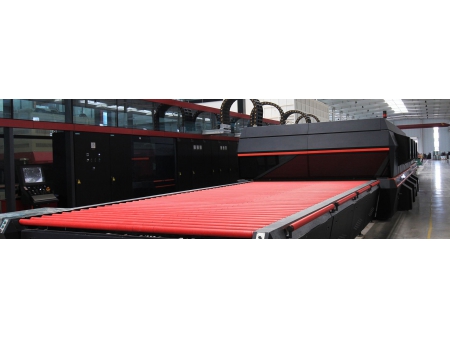T Series Glass Tempering Furnace
Standardly equipped with “Super Symmetric Heating Technology” and “Intelligent Heating Control Technology based on glass exit-chamber temperature,” the T-series tempering furnace ensures the production of ultra-high quality tempered glass. It supports large-scale, efficient, and stable production processes, making it a smart investment for both domestic and international leading glass processing enterprises aiming for industrial upgrades.
- T series- TG1E50 glass tempering furnace has been exported to Russia
- T series- TG1S60 glass tempering furnace was sold to Saudi Arabia
- T series- TG1E50 glass tempering furnace for local customer in Guangdong
- T series- TG1E60 glass tempering furnace was sold locally in Chongqing, China
-
Smart Control of Furnace Temperature
Improve Glass Quality and Reduce Energy Consumption with our smart furnace temperature control solution. With real-time monitoring of the glass temperature in the furnace, you can now achieve precise control, resulting in improved glass quality, higher yield, increased production capacity, and reduced energy consumption. Say goodbye to operational challenges and embrace the future of glass manufacturing.
-
Super Symmetrical Heating Partition
The extremely fine and symmetrical layout of heating control zones enables precise temperature control, leading to the production of ultra-high-quality tempered glass.
-
Gapless Forced Convection technology: (P)(S)
The overall optimized fan-forced convection system features convection air distributing pipes that are more densely arranged at an oblique angle to the longitudinal direction. This design ensures faster and more uniform heating of the glass, resulting in superior optical quality and higher stress uniformity. It is particularly suitable for high-quality large glass panels and Low-E glass curtain walls. The simple structure also allows for easy maintenance.
-
Intelligent Heating Control Module: (P)
The independent intelligent Heating Control Module, co-developed by NorthGlass and our professional partners, enables a precise & stable heating control with distinct advantages of agility, anti-interference and with a quick response time.
-
Super Flat & Spotless technology: (P)
Featuring an eight-fold stepped and interlaced arrangement of upper and lower air nozzles, combined with our patented lateral swing of upper and bottom chillers, this technology significantly improves glass uniformity and ensures more consistent optical performance. The result is lighter and more even anisotropy, delivering exceptional optical clarity and quality for industry-leading applications worldwide.
-
Triturbo Quenching Fan
Experience first-class energy efficiency, and minimal noise with our latest quenching fan. It features multi-dimensional curved blades, based on ternary flow technology to ensure the fan's efficacy, energy consumption, and minimal noise.
-
Nanoscale Thermal Insulation Material
The new nanoscale thermal insulation material, co-developed by NorthGlass and a national scientific research institute. provides better heat retention and energy savings by blocking the internal micro air convection.
-
Control System by Sub-stations
Each section of NorthGlass furnace is controlled by a distributed sub-station, easy for assembling and maintenance, stable & reliable glass processing.
-
Bending & Tempering technology by Rigid Rollers
The cylindrical pathway formed by upper and lower rigid conveyor rollers, curvature along production direction, can produce the curved & tempered glass with fit and performance without bearing excess force during formation.
-
Concave (inward) / Convex (outward) Bending and Tempering with Flexible Rollers
Make various glass shapes with our flexible roller concave (inward)/ convex (outward) bending and tempering technology. The length of the glass straight edge is not restricted by the width of the furnace thanks to the flexible rollers that comprise the conveying and quenching table. Different shaping needs can be met by combining convex bending with normal concave bending.
Note: (P) means patented technology; (S) refers to selective component
